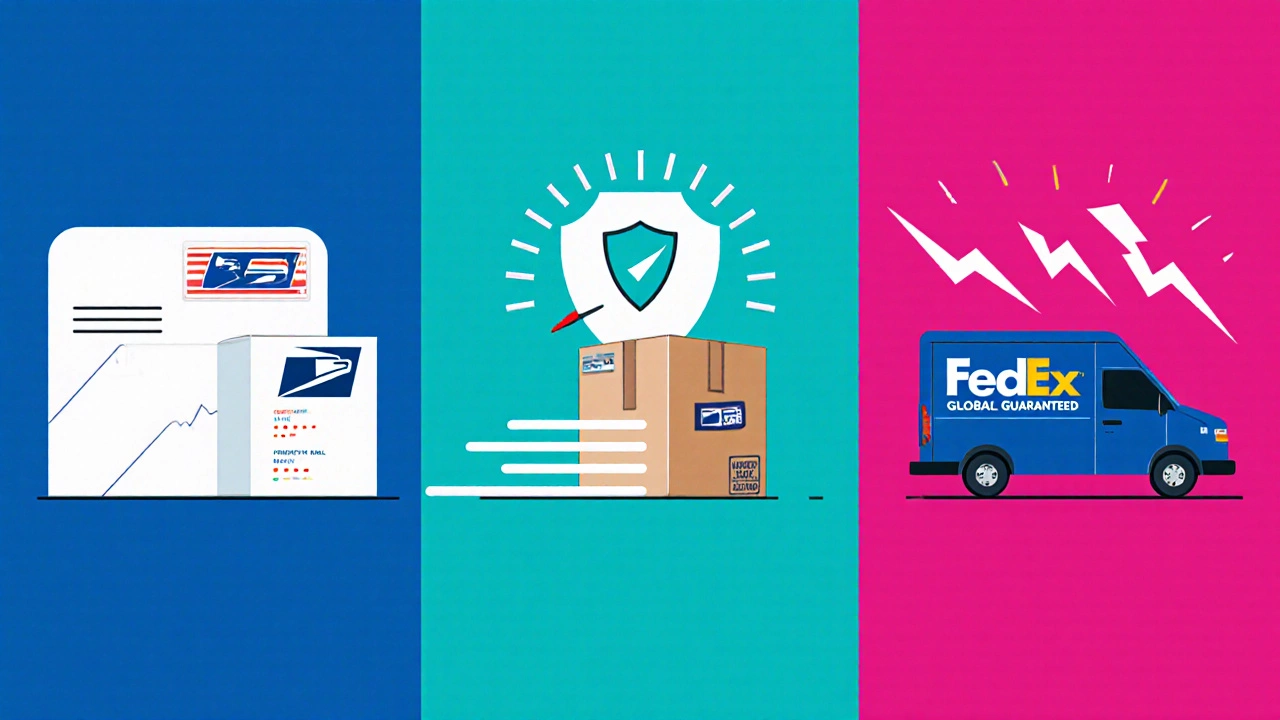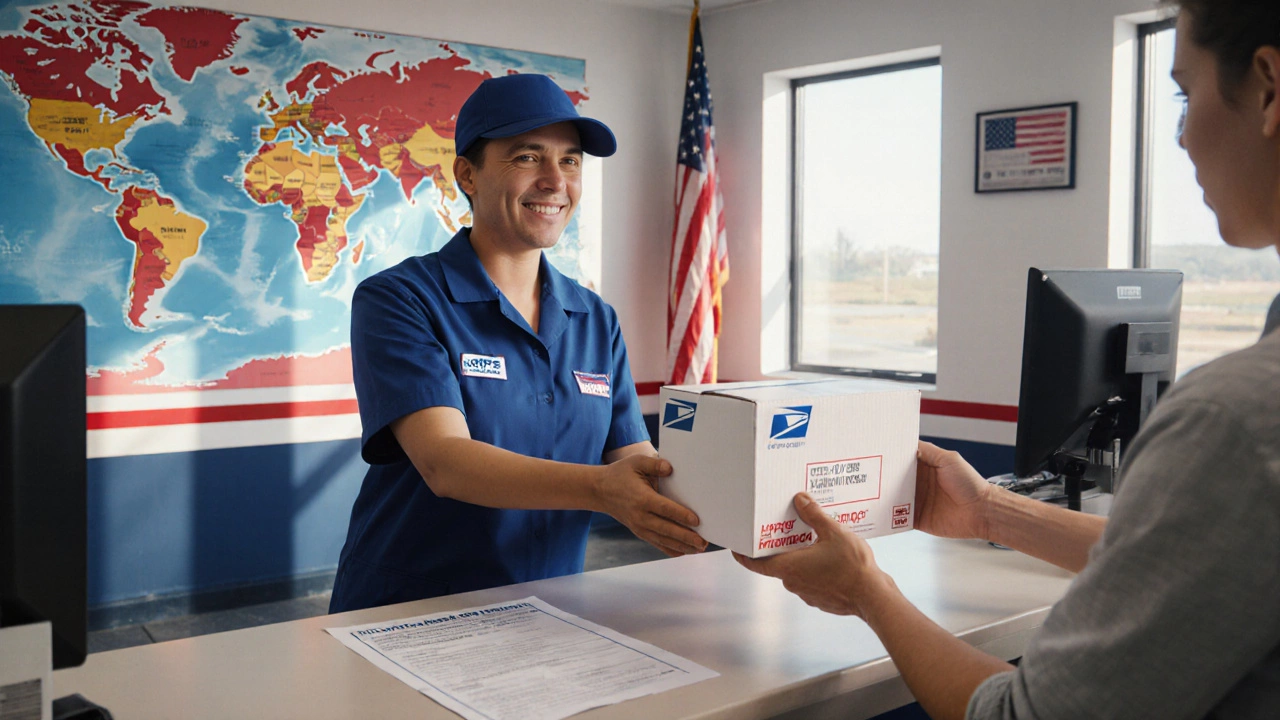USPS International Shipping Cost Calculator
When it comes to sending mail abroad, USPS is the United States Postal Service, the federal operator that handles both domestic and overseas postage. If you’re wondering whether your letters, parcels, or small‑business shipments can reach destinations beyond U.S. borders, the answer is a resounding yes - but the details matter. This guide walks you through every step, from eligibility and service options to costs, customs paperwork, and common pitfalls.
What Does "International Shipping" Mean for USPS?
In USPS terminology, USPS international shipping covers any piece of mail that originates in the United States and is destined for a foreign country. The service umbrella includes three main product families:
- Priority Mail International - a fast, tracked option for packages up to 70 lb.
- First‑Class Mail International - the cheapest way to send letters, postcards, and lightweight parcels.
- Global Express Guaranteed - a premium door‑to‑door service powered by FedEx, offering next‑day delivery to many major cities.
Each product has its own speed, tracking, and insurance guarantees, so picking the right one hinges on what you’re sending and how quickly it must arrive.
Eligibility: What Can You Ship?
USPS accepts a wide range of items for international dispatch, but there are limits:
- Weight and Size: Packages must not exceed 70 lb (31.75 kg) and 108 in (274 cm) combined length and girth.
- Content Restrictions: Dangerous goods (e.g., lithium batteries, fireworks) need special handling or are prohibited outright. Each destination country also has its own import rules.
- Packaging: The item must be securely packed, with appropriate cushioning for fragile goods. USPS provides free flat‑rate boxes for Priority Mail International.
If your shipment falls outside these parameters, you’ll need to work with a freight forwarder or a private carrier instead.
How to Prepare Your International Shipment
Getting the paperwork right saves time and avoids costly delays. Follow this checklist:
- Complete a Customs Declaration Form (usually PS Form 2976 for packages under 4 lb, or PS Form 2976‑A for heavier items).
- Accurately declare the contents, quantity, and value in U.S. dollars. Undervaluing items can result in fines.
- Attach the form visibly on the outside of the package, next to the shipping label.
- Check the destination country’s specific import restrictions - for example, many Middle Eastern nations block certain religious literature.
USPS also offers an online “Customs Forms” tool that prints the required paperwork at home, streamlining the process for frequent shippers.
Cost Structure: How Much Does USPS International Shipping Cost?
Pricing varies by service, weight, and destination zone. Below is a snapshot of 2025 rates for a 2‑lb package to three major regions (rates are in U.S. dollars and include all taxes):
| Service | North America (Canada, Mexico) | Europe (e.g., UK, Germany) | Asia‑Pacific (e.g., Japan, Australia) |
|---|---|---|---|
| First‑Class Mail International | $12.30 | $15.85 | $18.70 |
| Priority Mail International | $31.20 | $36.10 | $42.00 |
| Global Express Guaranteed | $98.50 | $112.75 | $124.30 |
These figures are a baseline; adding insurance, extra tracking, or special handling will increase the total. Use the USPS “Price Calculator” on the website for a precise quote based on zip codes.

Tracking and Insurance Options
All three international services provide some level of tracking, but the depth differs:
- First‑Class Mail International offers limited tracking in only a handful of countries. For high‑value items, add USPS Tracking for a small fee.
- Priority Mail International includes end‑to‑end tracking to most destinations, plus up to $100 of insurance (higher insurance can be purchased).
- Global Express Guaranteed provides real‑time updates and up to $200 of insurance by default.
Always keep the tracking number handy; you can monitor progress on the USPS website or via the mobile app.
Customs Clearance: What to Expect
After your package leaves the U.S., it encounters customs in the destination country. The speed of clearance depends on:
- The completeness of your customs declaration.
- The recipient’s ability to pay duties and taxes (many countries require the buyer to settle fees before delivery).
- Whether the item falls under a restricted or prohibited category.
USPS does not collect foreign duties; those costs are the recipient’s responsibility unless you opt for a “Delivered Duty Paid” (DDP) arrangement through a private carrier.
Common Pitfalls and How to Avoid Them
Even seasoned shippers run into snags. Here are the most frequent issues and quick fixes:
- Incorrect Address Formatting: Use the destination country’s postal standards. For example, Canada requires the province abbreviation (e.g., ON) and a six‑character postal code.
- Missing or Incomplete Customs Forms: Double‑check every line; a blank “value” field triggers a hold.
- Undervaluing Goods: While it may save on duty, under‑declaring can lead to penalties or seizure.
- Packaging Too Small: UPS and FedEx often accept parcels that are too tight, but USPS may reject items that can’t be sealed properly.
- Choosing the Wrong Service: If you need five‑day delivery to Europe, Priority Mail International is usually faster and cheaper than First‑Class Mail International.
Taking a few extra minutes to verify these details pays off in smoother deliveries.

When to Consider Alternatives to USPS
USPS is a solid choice for most small‑to‑medium packages, but certain scenarios call for other carriers:
- Heavy or Oversized Shipments: For anything over 70 lb, look to freight forwarders or UPS Freight.
- Time‑Critical Deliveries: DHL Express can guarantee same‑day service to many major cities.
- High‑Value Electronics: Specialized carriers offer higher insurance limits and more robust tracking.
Weigh cost, speed, and reliability before deciding.
Step‑by‑Step: Shipping a Package with USPS International
- Weigh and measure your item. Make sure it fits within the 70 lb / 108 in limit.
- Select a service (First‑Class, Priority, or Global Express) on the USPS website or at a post office.
- Print the shipping label and the appropriate customs declaration form.
- Attach the label and customs form securely to the package.
- Drop the package off at a USPS collection box, post office, or schedule a pickup.
- Save the tracking number and monitor the shipment online.
- If you receive a “customs hold” notice, promptly contact the recipient so they can settle any duties.
Following these steps reduces the chance of surprises and gets your parcel to its overseas destination with minimal hassle.
Key Takeaways
- USPS ships to over 190 countries using three main services.
- First‑Class Mail International is cheapest; Priority Mail International balances cost and speed; Global Express Guaranteed is the fastest, premium option.
- Proper customs paperwork and accurate value declarations are critical for smooth clearance.
- Tracking is available on all services, but depth varies.
- For very heavy, oversized, or ultra‑time‑sensitive shipments, consider private carriers.
Can I ship a package to Canada with USPS?
Yes. Canada is one of the most popular international destinations for USPS. You can use First‑Class Mail International for letters and small parcels, or Priority Mail International for faster delivery and tracking.
What is the fastest USPS international service?
Global Express Guaranteed (GEG) is the quickest USPS‑offered option. Partnered with FedEx, it provides door‑to‑door delivery in 1‑3 business days to many major cities worldwide.
Do I need a customs form for a $30 gift?
Yes. Any item leaving the U.S. requires a customs declaration, regardless of value. For gifts under $50, you can use the simple PS Form 2976, but you still must list the exact value and describe the contents.
Can I track a First‑Class Mail International shipment?
Tracking is limited. First‑Class Mail International offers basic tracking in a handful of countries. If you need detailed visibility, add USPS Tracking for an extra fee or upgrade to Priority Mail International.
What happens if my package is held in customs?
Customs will notify the recipient (or you, if you used the “Collect on Delivery” service). The recipient must pay any duties, taxes, or fees before the carrier releases the package. You can often resolve the issue by providing additional documentation or a corrected invoice.





